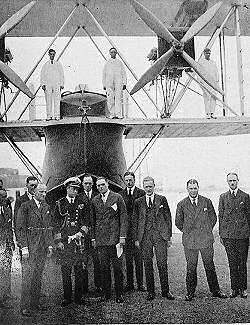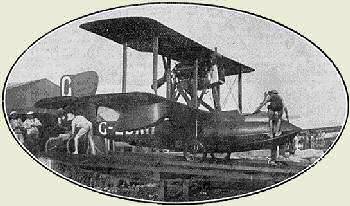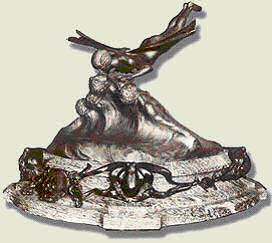|
|
The Channel Islands and the Great War
|
|
HENRY (or
HENRI) CHARLES BIARD
|
|

A Visit to Supermarines by the Prince
of Wales
(Henry is 4th from the right of this photograph,
while RJ Mitchell is 3rd from the right)
|
"Civvy Street" and the
Schneider Trophy
Unemployment was a fate that befell the many thousands
of Officers and Other Ranks following the Great War. In
Henry's case, he was successful in competition with some
200 other ex-pilots who applied for six positions as company
test pilots with the up and coming Supermarine Aviation
Works Ltd. based at Woolston, Southampton. The work involved
the testing of newly designed aircraft as well production
aircraft and in due course, he became the Chief Test Pilot.
In 1919, Supermarine established a company, British Marine
Air Navigation Ltd. (later to become part of Imperial
Airways), to operate the first cross-Channel air service
from Woolston to Le Havre in France, and a few years or
so later to Cherbourg and the Channel Islands. Henry was
among the pilots involved in operating the aircraft, a
risky business in those days with few instruments, often
in adverse weather conditions, and a cockpit open to the
elements. He recounted one flight to Le Havre that lasted
5 hours flying into a gale, and later an accident to a
fellow pilot off Alderney on the inauguration service
to Guernsey.
In 1922, Hubert Scott-Paine decided to fund and enter
an aircraft in the Schneider Trophy competition.
Italy had won the trophy in the previous two years of
competition, and another success in 1922 would mean that
the Italians would retain the trophy. Henry was selected
as the race pilot flying the Sea Lion II around a 175
mile course in the Bay of Naples.
|
|

Henry Biard's Supermarine Sea Lion
II
|
The final competitors for the Trophy consisted
of three Italians and Henry, this coming after the French
team of two pilots mysteriously withdrawing before the
flying competition got under way. The race saw the Italians
taking and holding the lead for the first six or seven
laps and bunching so that any overtaking would mean covering
a greater distance, however, Henry decided to pass them
by flying over the top! This manoeuvre took him into a
lead from which the Italians could not recover. Thus the
Italians were prevented from winning the Trophy outright,
an event that Great Britain would achieve in 1931. Henry
would enter twice more, finishing third to the USA at
Cowes in 1923, and crashing during trials in 1925 at Baltimore,
MD in the USA.

The Schneider Trophy
|
Later Years

Henry Biard in 1933/34
|
Henry continued with Supermarine until 1933, when he
became redundant a few years after the company had been
taken over by Vickers-Armstrong.
Later on, he would maintain his links to the Channel
Islands, working with the Guernsey Meteorology Service.
During the Second World War, he would return to the RAF
in 1939 as a communications pilot operating out of Hendon,
before returning again to Guernsey to live and work after
the War.
He died on 18th January 1966 at Charminster in Dorset.
Henry Biard's Autobiography "Wings"
As has already been commented several times, the autobiography
lacks a clear chronology to accurately relate events to
dates, although it covers the period between 1909 and
1934. It is a collection of aviation anecdotes, some humorous,
some serious, the latter serving to remind the reader
of the perilous nature of the early days of heavier than
air flight. Some of his predictions for the expansion
of aviation now appear rather wide of the mark, e.g. the
continued major use of seaplanes for over-water flying
and there being more private planes purchased than motor
cars! But such predictions would not have been out of
place seventy years ago. However, he also projected that
a further war might be a fact within five years, and he
fully acknowledged RJ Mitchell's outstanding aircraft
design skills, that were, fortunately for the United Kingdom,
later so evident in the Spitfire!
The book has been long out of print, but copies might
be found via library request systems or www.abebooks.co.uk.
|
Acknowledgements
With thanks to Peter Tabb, author of "A Peculiar Occupation",
for providing a number of pointers regarding Henry Biard's life
and career.
Author's Note
This brief overview of Henry Biard's career covers
a period that obviously exceeds the length of the Great War,
however, it looks at how in his case, he learnt to fly, at some
of his activities during the Great War, and then at his post-war
experiences, not least winning the Schneider Trophy in 1922.
It may not "sit" naturally within a Great War website,
but it is nevertheless worth including because of the part he
played in the evolution of aviation which coincided with the
Great War.
It is hoped that readers with some additional knowledge of
Henry Biard will be good enough to pass it on for possible inclusion.
© 2007 Barrie Bertram
Contact
Barrie
Page 2 
|
|
|